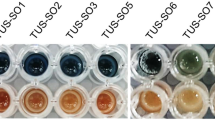Abstract
Microorganisms which can assimilate 2-phenylethanol were screened from soil for oxidation of various alcohols into carbonyl compounds. One strain, identified as Brevibacterium sp. KU1309, had high oxidative activity towards ArCH(CH3)CH2OH and Ar(CH2)nOH. When the substrate concentration was 0.1 ∼ 0.4% (w/v), the oxidation reaction proceeded smoothly (6 ∼ 96 h), and the corresponding carboxylates were obtained in good yields (68 ∼ 87%).
Similar content being viewed by others
References
Asano Y (2002) Overview of screening for new microbial catalysts and their uses in organic synthesis-selection and optimization of biocatalysts. J. Biotech. 94: 65-72.
Burton SG (2003) Oxidizing enzymes as biocatalysts. Trends Biotechnol. 21: 543-549.
Gandolfi R, Ferrara N, Molinari F (2001) An easy and efficient method for the production of carboxylic acids and aldehydes by microbial oxidation of primary alcohols. Tetrahedron Lett. 42: 513-514.
Hummel W, Kuzu M, Geueke B (2003) An efficient and selective enzymatic oxidation system for the synthesis of enantiomerically pure D-tert-leucine. Organic Lett. 5: 3649-3650.
Karube I, Nomura Y (2000) Enzyme sensors for environmental analysis. J. Mol. Cat. B Enzym. 10: 177-181.
Miyamoto K, Ohta H (1992) Enantioselective oxidation of mandelic acid using a phenylmalonate metabolizing pathway of a soil bacterium Alcaligenes bronchisepticus KU 1201. Biotechnol. Lett. 14: 363-366.
Nakamura K, Yamanaka R, Matsuda T, Harada T (2003) Recent development in asymmetric reduction of ketones with biocatalysts. Tetrahedron: Asymmetry 14: 2659-2681.
Ohta H, Tetsukawa H (1979) Enantiotopically selective oxidation of 1,3-diols with microorganism. Chem. Lett. 1379-1380.
Ohta H, Tetsukawa H (1981) Enantiotopically selective oxidation of 1,5-diols with Gluconobacters preparation of (S)-mevalonolactone. Agric. Biol. Chem. 45: 1896-1896.
Riebel BR, Gibbs PR, Wellborn WB, Bommarius AS (2003) Cofactor regeneration of both NAD+from NADH and NADP+ from NADPH:NADH oxidase from Lactobacillus sanfranciscensis. Adv. Synth. Catal. 345: 707-712.
Romano A, Gandolfi R, Nitti P, Rollini M, Molonari F (2002) Acetic acid bacteria as enantioselective biocatalysts. J. Mol. Cat. B Enzym. 17: 235-240.
Sheldon RA, Arends IWCE, Dijksman A (2000) New developments in catalytic alcohol oxidations for fine chemicals synthesis. Catal. Today 57: 157-166.
Tsuchiya S, Miyamoto K, Ohta H (1992) Highly efficient conversion of (±)-madelic acid to its (R)-enantiomer by combination of enzyme-mediated oxidation and reduction. Biotechnol. Lett. 14: 1137-1142.
Author information
Authors and Affiliations
Rights and permissions
About this article
Cite this article
Miyamoto, K., Hirano, Ji. & Ohta, H. Efficient oxidation of alcohols by a 2-phenylethanol-degrading Brevibacterium sp.. Biotechnology Letters 26, 1385–1388 (2004). https://doi.org/10.1023/B:BILE.0000045637.33516.65
Issue Date:
DOI: https://doi.org/10.1023/B:BILE.0000045637.33516.65




